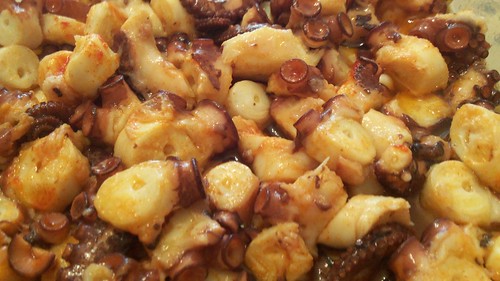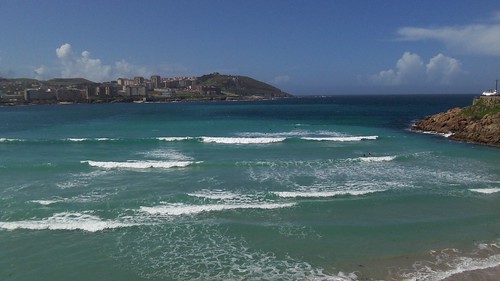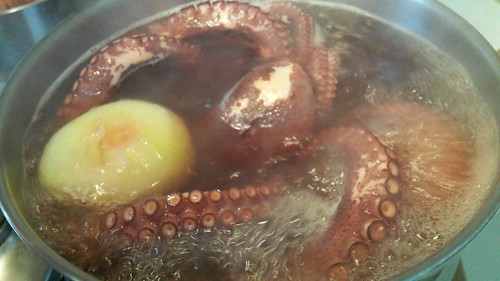It was always exciting going to eat at your friend’s house
after school. The different routines, customs (I once had to slyly retrieve a
slice of cucumber from my mouth, whilst my friends family said grace), and of
course the food. This month I found myself in Galicia, the birth place of my Spanish
friends, Raquel and Sandra. Despite being older now, I was nonetheless very
excited to be invited to their parents’ houses for lunch, and as I quickly
learnt, no lunch in Galicia is complete without pulpo (octopus).
My first morning in A coruña I ran to see the sea. I say
sea, but really it is the fierce Atlantic Ocean that, which continually
swallows the promenade of the city and delivers some of the world’s best
seafood. Menus are full of it, and so are the restaurant windows, packed to the
rafters with bonkers looking shells and molluscs. Even in the countryside pulperias (restaurants specialising in
pulpo) are a firm fixture in every village. Pulpo or polbo in Gallego, is what every Galician misses when they are
abroad. I’ve heard stories of a Gallego chef in London flying over bottles of
Galician water so that he could cook pulpo properly. So though to the unaccustomed
eye it is a daunting dish, there was no way I was wangling my way out of trying
it.
When I arrived at Raquel’s house a whole pulpo was bubbling
away on the stove. The markets are amazing, and picking up a whole octopus here
is like popping out for a loaf of bread at home. I am told it’s better to buy it frozen, apparently
it gives a much better texture, otherwise you have to whack it several times to
tenderise it. In fact just like steak there are those who prefer it well done,
so depending on your preferences and the size of the pulpo, the cooking time
can be anything from 25 to 45 minutes. However, before it meets its destiny in
the giant saucepan Sandra’s mum says you have to asustar (scare) the pulpo by baptising it in boiling water three
times, which helps keep the skin on.
Once the pulpo had been boiled and then rested, Raquel’s dad
set to work with the scissors, snipping the legs into 1cm discs, pure white
flesh surrounded by a purple skin and tiny suckers. Olive oil, sea salt and pimenton (sweet or spicy paprika) were
generously poured over. In Raquel’s house we ate the pulpo with potatoes as a
hefty second course at lunch. With Sandra’s family in Ourense it was served on
a typical wooden board and we used cocktail sticks to spear our catch. In both
houses we raced to dip delicious Galician crusty bread into the sea infused oil,
ate too much and laughed a lot!
Each morsel is sweet like a scallop or crab but the texture
is meatier and the flavour more robust. Like most things here, when you eat it
the Ocean comes crashing back to you. Perhaps that is why it makes such a
hearty home coming for the Gallegos. I now understand why to Raquel the Mediterranean
Sea we walked along in Valencia no tiene
nada que ver (is no comparison) to the mighty roar of the Atlantic, but
perhaps it is what gets fished out of it that she misses the most.
Fork notes
- Some boil the pulpo with a whole peeled onion and others just with water
- The cooking water can be used to afterwards to boil the potatoes while the pulpo is resting
- If you get served it as a racion of tapas in a bar, look for the palitos (cocktail sticks) and you will look like a true Gallego
- It was traditionally cooked in copper pots
- Moitas Grazas to my favourite Gallegos Juan Pablo, Raquel, Sandra, and their wonderful families. Big love xxxxxxx





No hay comentarios:
Publicar un comentario